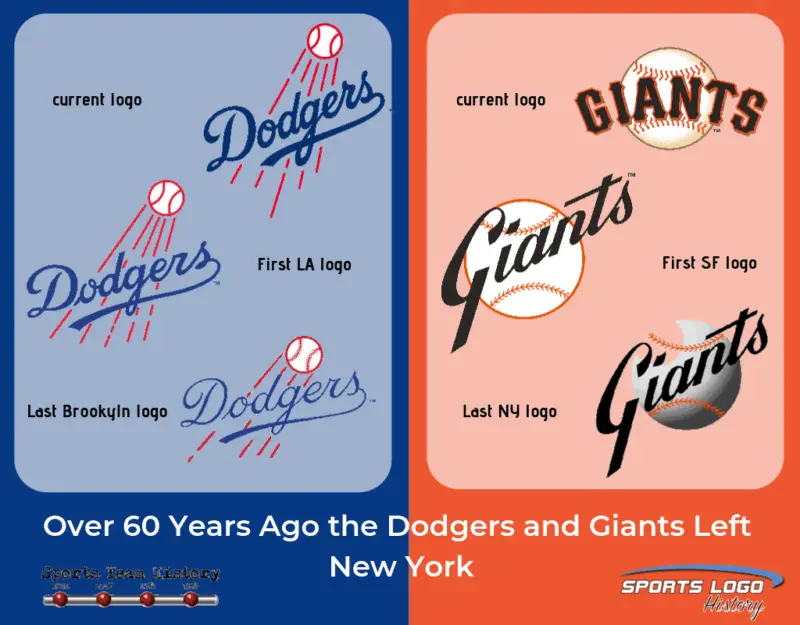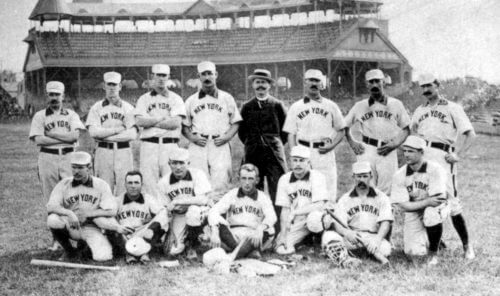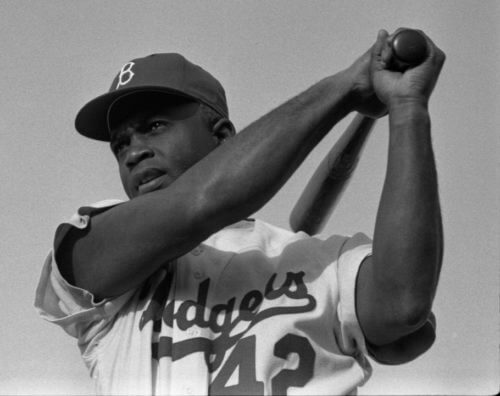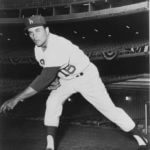
Every self-respecting baseball fan will never forget this date - May 28, 1957… For as exactly than the face of New York baseball was forever changed when the Giants and Dodgers—two teams that had been playing in the Big Apple since the late 1800s—abandoned the city for California. To this day, their relocation remains a touchy subject to longtime fans throughout the five boroughs. What drove them to leave town in the first place?
A Long Way from the Polo Grounds. Bill Rigney and Walter Alston.
For more than a half-century, the Brooklyn Dodgers and New York Giants were two of baseball's leading lights. They had the beautiful ballparks, the winning pedigree, the stars past and present. More importantly, though, they both had that ineffable quality that elevates a team into something more, an unofficial civic institution: The Giants' home, the Polo Grounds, was the very essence of Manhattan.
Then, on May 28, 1957, MLB owners unanimously voted to allow both teams to up and leave the Big Apple for California. You may already know that part; all these years later, it still stings for some (just ask the next elderly guy you see at a New York Mets game). But just how did this happen? How did two teams seem so synonymous with a specific place and people wind up 3,000 miles away? How did baseball history get so thoroughly turned on its head? That is what we are going to find out.
Let’s analyze all the circumstances to better understand and the reasons. Throughout the history of major league baseball in America, there has been only one city, which has housed more than two teams. That city, of course, is New York, which was home to the New York Yankees, Brooklyn Dodgers, and New York Giants for more than a half-century. That all changed in 1957 when club owners Walter O'Malley and Horace Stoneham yanked the Dodgers and the Giants out of New York to move to the west coast.
To qualify as the greatest player for this team, the player must have played one season for this team. If not, we will remove the player.
* verifies that player has played for this team as an added player by a fan.
New York Giants 1888
Stoneham, and especially O'Malley, saw a trend in New York, which included the movement of people from urban areas into the suburbs, the influence of television on baseball, and the decay of New York's stadiums. Recognizing that this was happening, they decided that conditions in New York had to change or they would find a new location that fit their organizations' needs more closely. This baseball exodus from New York had many effects, but mostly it expedited the process of urban decay. That is to say, the very reason that the owners drew their teams out of New York was then only sped up as a result of those teams' absence. This was especially true for Brooklyn, which was far more attached to the Dodgers than Manhattan was to the Giants. Even today, the reasons why the Brooklyn Dodgers and New York Giants left for California, and the legitimacy behind those reasons, are hotly debated. In the end, it would seem that both teams improved fiscally after they moved west, but the question of whether those moves were still justified is an interesting one. Both teams were definitely motivated by money, as any profit earning business should be. Prior to and during the 1957 season, the Giants and Dodgers both cited financial problems as the main motivation for leaving New York! For some, this claim is hard to swallow, especially from the side of the Brooklyn Dodgers. A study was done by Major League Baseball actually showed that from 1952 to 1956, the Dodgers led all teams in profit. The Giants were not doing as well as the Dodgers. Despite this, they still managed to do all right, reaping a profit in 1954, 1955, and 1956 in the span of the study.
Says Jackie Robinson
In many ways, O'Malley and Stoneham understood, as competent businessmen, that although they could survive and maybe do reasonably well in New York, there was an opportunity in California to thrive on a fan base of millions of people who were tired of watching the second class baseball of the Pacific Coast League. Understandably, many fans do not like being reminded that the sports that they love so much and rely on as an escape from the business of everyday life are indeed a part of the business world and are subject to its demands for fiscal success. As a businessman, O'Malley saw that although he was not saving a dying franchise, he had an opportunity to tum a healthy franchise into a wealthy franchise by making the move. O'Malley and Stoneham understood that due to factors beyond their control, including television and a middle-class urban exodus, financial matters would only get worse in New York.
One very apparent reason was sagging attendance. Both ball clubs were suffering from serious attendance problems. In 1956, the Giants played before merely 629,159 spectators at their home games in the Polo Grounds. This figure is less than half of what they played in 1947. The meager increase in 1957 to 653,903 was probably only due to a small number of fans whose sentiment for their departing team drove them off of their couches to witness the last few games of the New York Giants. Although Dodger attendance suffered as well, it was not down to the point that the Giants' attendance was. Still, the Dodgers' attendance slide was definitely noticeable. At the beginning of the 1957 season, only 182,000 saw fifteen home games for the Brooks, while the Yankees, as a point of comparison, drew 81,000 in bad weather during a three-game homestand. With the World Series victory, the Dodgers had become winners, and the fans in Brooklyn at least in some respect lost interest. Although success was not the sole factor in the attendance problems, in the Dodgers' case it definitely had an impact.
To qualify as the greatest player for this team, the player must have played one season for this team. If not, we will remove the player.
* verifies that player has played for this team as an added player by a fan.
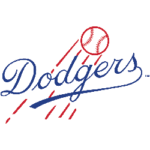 Sports Team History
Sports Team History Brooklyn Dodgers Primary Logo 1945 - 1957
Television contracts were another reason that these two franchises felt that they might make more money on the west coast. People were just starting to understand what major moneymakers professional sports teams could be when coupled with television. In 1957, the Dodgers brought in $750,000 a year with their network television contract. The Giants' contract was less lucrative, bringing in $600,000 per year in revenues according to the contract they had agreed to. The fact that these contracts were for network television, that is, telecast free to the television-owning public, made them much less financially rewarding than they could have been. California suggested using cable television, an up and coming form of television that viewers had to pay for, in order to watch the Dodgers and Giants. Using this idea, San Francisco and Los Angeles were both able to offer television contracts valued at $2 million a year. There were offers for cable television contracts in New York for millions of dollars as well, but these offers were made at a point when the owners had set their hearts and minds on getting their new stadiums. Combined with the hope of new stadiums, these lucrative television contracts proved to be one of the large attractions for the move made by the Giants and Dodgers.
One other, minor reason that the two clubs wanted to leave for greener pastures was their unhappiness with the standing five percent admissions tax for all amusements in New York. The tax applied to all sorts of industries in the city, including sports, theatre, and amusement parks such as Coney Island. When the owners inquired about it, the city put its foot down refusing to do away with the tax. It netted the city almost $9 million a year. The refusal of the city to lighten up on this tax only increased the financial difficulties that the owners perceived they had, and by doing so, added to their reasons to leave.
And we definitely should not miss this reason - New York's urban demographic could no longer support three baseball teams, and California was an excellent option for the Dodger and Giant owners. It offered large cities that were hungry for major league baseball.
With all the benefits which teams gathered during their move, there were definitely some negatives to moving to the coast. For one, the Giants were forced to pay damages to two organizations. They would have to pay the Pacific Coast League one million dollars in damages. The Giants would also have to compensate the San Francisco Seals, a member of the Pacific Coast League, with damages of around $125,000. These damages were necessary because the introduction of major league baseball in California would injure the Pacific Coast League by destroying the Seals' market. Another negative in the Giant's move to California was their initial home. Stadiums take time to build, and until the Giants' new home was ready they would have to play in the Seals' stadium, which seated only 22,000 people. Despite these problems, the deal was still a very attractive one for the Giants, especially when the only other option was sharing a stadium with the Yankees in New York City once their lease ran out at the decrepit Polo Grounds.
 Sports Team History
Sports Team History New York Giants Primary Logo 1947 - 1957
With two baseball teams leaving that had been rooted in New York City for over sixty years each, there is little doubt that their sudden move would have an effect on the city. The Dodgers had been in Brooklyn since 1890. The Giants had been in Manhattan even longer, arriving in the city in 1883. One overt effect that each move had was animosity from the fans toward the owners of each ball club. By the end of the 1957 season, most New York Giant fans were very unhappy with the leadership of Horace Stoneham. Many Dodger fans reacted similarly. In fact, Walter O'Malley was hated even more than Stoneham. In the end, what Walter O'Malley was guilty of, more than any other baseball owner before him, was showing the public that baseball really was a business. Not all of the fans reacted so negatively when the teams announced the move. Many journalists of the times noticed that Giants fans actually relaxed some when the move was announced. In reality, most of the fans went through an entire array of emotions, including sadness and anger obviously. Of course, these reactions were to be expected, but in many ways, they were less intense than people would have expected. After the National League approved the possibility of the franchises moving, there was not a strong response. City Hall did not receive a great outcry from fans and city residents to keep their teams in New York. In fact, many Dodger fans were ready to say good riddance by the time the move was actually announced. Obviously, the fans' emotional reaction is to be expected. O'Malley's memory in New York is definitely not a positive one, and it has kept him out of the Baseball Hall of Fame at Cooperstown, despite what some feel is a very worthy career. Many employees were also affected by the move. Numerous Giant employees were deeply attached to their home at the Polo Grounds and had worked there for many years. They were emotionally saddened to see the team leave its home, which it had been in for quite a long time. These people were losing more than just their job. They obviously felt something very special for their New York Giants, and when they left a part of them was leaving with them.
Portrait of baseball player Ron Perranoski
Certainly, one area that the Giants and Dodgers affected when they left New York was the transportation industry. In fact, the Transit Authority expected to lose upwards of $300,000 a year in revenues. People obviously had to get to games in some way, especially those living in urban areas far from the stadium. With little or no parking, the transportation system was given a large boost by the baseball teams' presence. Now that boost would be gone--just another example of one way that the Dodgers' and Giants' decision to leave New York City sped up the urban deterioration that was already occurring. Yet another result of the cross-continent leap of the Dodgers and Giants is the effect it had on the city's rivalries. All of a sudden two of the top National League teams were gone from New York City. This sudden disappearance took one of the best things about the Giants' and the Dodgers' stay there, their close rivalry. There would be no more jibes between coworkers about whom they rooted for. Also, the debates would end. Suddenly, the Dodger fans could not get into huge arguments with a guy from work that swore that Willie Mays was better than Duke Snider. These little rivalries gave a small bit of almost indefinable something to New York City, which was lost forever. In fact, the one reason that the Giants' attendance was even at the slightly respectable level that it was was because of the rivalry games against the Dodgers, which drew very large crowds to the end. The Dodgers, although not relying on it as heavily, also took a large boost in attendance from the games that pitted them against the Giants. Even when the Mets returned National League baseball to New York City, they were in the opposite league from the Yankees. Thus, this sense of close rivalry has been lost to the city of New York ever since.
So as we can see how - the history of baseball in the United States during the twentieth century in many ways mirrors and affects the history of the nation in general. This research also shows the very real impact that sports have on its city and the impact a city has on its sports. And we should never forget, that for the fans or just ordinary people sports - in this particular case baseball - is about emotions, spirit, something that can unite, however for those, who own these clubs - it was, is and will always be about money.
Resources of the New York Giants and Brooklyn Dodgers, excellent article of the first West Coast game between the Dodgers and Giants called "A Long Way from the Polo Grounds," logo history of New York Giants, Brooklyn Dodgers, San Francisco Giants and the Los Angeles Dodgers.
Sports Team History takes a look at the history and the logo history of each and every professional sports team to have ever existed from the MLB, MLS, NBA, NCAA, NFL, NHL, WNBA, XFL, ABA, AAF or USFL.
Our partner site is Sports Logo History which is a community of sports logo enthusiasts who enjoys the history of each team’s logo history.

